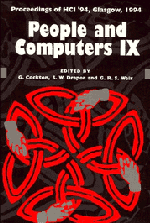Book contents
- Frontmatter
- Contents
- Preface: HCI'94 – You Probably Haven't Seen It All Before
- Part I Invited Papers
- 1 The Future of Graphic User Interfaces: Personal Role Managers
- 2 Beyond the Workstation: Mediaspaces and Augmented Reality
- Part II Methodology of Interactive Systems Development
- Crafting Interaction: Styles, Metaphors, Modalities and Agents
- Modelling Humans, Computers and their Interaction
- Notations and Tools for Design
- Part VI Computer-Supported Cooperative Work
- Author Index
- Keyword Index
1 - The Future of Graphic User Interfaces: Personal Role Managers
Published online by Cambridge University Press: 04 August 2010
- Frontmatter
- Contents
- Preface: HCI'94 – You Probably Haven't Seen It All Before
- Part I Invited Papers
- 1 The Future of Graphic User Interfaces: Personal Role Managers
- 2 Beyond the Workstation: Mediaspaces and Augmented Reality
- Part II Methodology of Interactive Systems Development
- Crafting Interaction: Styles, Metaphors, Modalities and Agents
- Modelling Humans, Computers and their Interaction
- Notations and Tools for Design
- Part VI Computer-Supported Cooperative Work
- Author Index
- Keyword Index
Summary
Personal computer users typically manage hundreds of directories and thousands of files with hierarchically structured file managers, plus archaic cluttered-desktop window managers, and iconic representations of applications. These users must deal with the annoying overhead of window housekeeping and the greater burden of mapping their organizational roles onto the unnecessarily rigid hierarchy. An alternate approach is presented, Personal Role Manager (PRM), to structure the screen layout and the interface tools to better match the multiple roles that individuals have in an organization. Each role has a vision statement, schedule, hierarchy of tasks, set of people, and collection of documents.
Keywords: personal role manager, desktop metaphor, graphic user interface, coordination, computer-supported cooperative work (CSCW).
Introduction
The transition from the first generation command line interfaces (such as DOS 3 or UNIX) to second generation point-and-click graphical user interfaces (GUIs) was accompanied by an important metaphorical shift. The older systems required users to understand computerdomain concepts such as executable binary software (the .EXE or .COM files), file naming rules, and hierarchical directories. The designers of second generation GUIs presented users with more meaningful metaphors and supported direct manipulation interactions (Shneiderman, 1982). The graphical user interface offered a desktop with applications represented as icons, documents organized into folders, and even a trashcan as an affordance for the delete action. This visual representation of the world of action made objects and actions visible, permitted rapid, incremental and reversible actions, and emphasized pointing and clicking instead of keyboarding.
The current third generation approach emphasizes a “docu-centric” design (Microsoft's Object Linking and Embedding or Apple's OpenDoc Architecture), unified suites of software, and “information at your fingertips” through hypertext linking.
- Type
- Chapter
- Information
- People and Computers , pp. 3 - 8Publisher: Cambridge University PressPrint publication year: 1994
- 10
- Cited by



